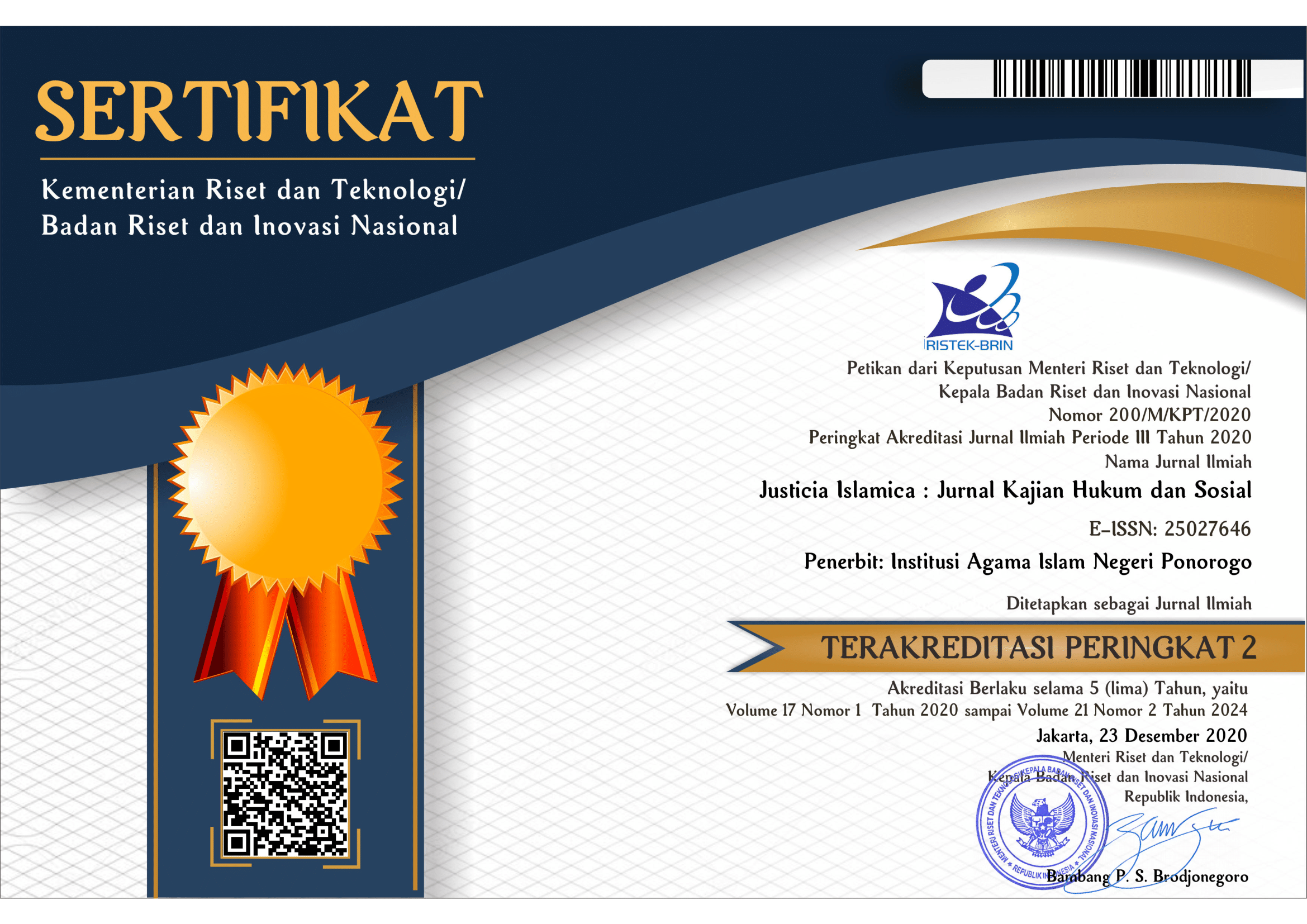The Settlement Principles and Effectiveness of Divorce by Mediation of Islamic Civil Perspective: A Critical Review of the Supreme Court Regulation
DOI:
https://doi.org/10.21154/justicia.v18i1.2139Keywords:
pillar of mediation, value of efficiency, settlement of divorceAbstract
Mediation of divorce is expected to be able to suppress the settlement of the case peacefully. In principle, based on the Elucidation of Law Number 1 of 19 74 concerning Marriage, marriage aims to form a happy and eternal family. Therefore, it is urgent to find mediation pillars in resolving divorce cases. To find the idea in response to these problems, there are three approaches: 1) laws and regulations, by examining them that relate to divorce settlement through mediation in religious courts; Supreme Court Regulation Numb. 1 of 2016, Civil Procedure Code. 2) from the view of experts/scholars, the conceptual approach is used to find ideas by building concepts and arguments according to the issues to be examined to find the efficiency in the implementation of mediation. 3) Philosophy, studying literacy related to the theme of the study to capture philosophical content in finding the pillars of mediation in the study of Islamic civil law. The findings in this study are the pillars of mediation whose relevance to divorce disputes should be stated: 1) Essence of Deliberation to reach an agreement. 2) The essence of mutual forgiveness is to end the dispute. 3) The essence of respecting the rights of others, of avoiding the nature of egoism. 4) The essence of justice is giving equal opportunity to speak to each other so that both parties have the same rights. The efficiency of the mediation implementation in the settlement of divorce can be achieved by mediating: 1) Regarding the care and education of children, 2) the cost of living of ex-wife, and 3) guarantee for the maintenance of the joint property after the termination of a marriage.
References
Abbas, Syahrizal. Mediasi Dalam Perspektif Hukum Syariah. Jakarta: Kencana, 2009.
All, George F. Irani et. Ritual Of Reconciliation, Arab Islamic Perspectif. New York: University Press Of America, 2007.
Amarini, Indriati. “Penyelesaian Sengketa Yang Efektif Dan Efisien Melalui Optimalisasi Mediasi Di Pengadilan.” Jurnal Kosmik Hukum 16, no. 2 (2016): 1”“20.
Asmawati. “Dosen Hukum Perdata Fakultas Hukum Univ. Jambi.” Ilmu Hukum 6, no. 4 (1999).
Damar Ariotomo. “Harapan Optimalisasi Proses Mediasi Pasca Perma Nomor 1 Tahun 2016 | Adnan Buyung Nasution And Partners,” 2016.
Djaenab, Djaenab. “Efektifitas Dan Berfungsinya Hukum Dalam Masyarakat.” Ash-Shahabah 4, no. 2 (2018): 148”“53.
El-Amin, Ahmed Shoim. “Konsep Mediasi Dalam Hukum Islam.” Al-Munqidz: Jurnal Kajian Keislaman 2, no. 1 (2013): 21”“30.
Hanifah, Mardalena. “Kajian Yuridis : Mediasi Sebagai Alternatif Penyelesaian Sengketa Perdata Di Pengadilan.” Jurnal Hukum Acara Perdata ADHAPER 2 (2016).
J. folberg et. al. Mediation: Comprehensive Guide in Resolving Conflict without Litigation. Cambridge: Cambridge University Press, 1984.
Krzeszowski, Tomasz P. Contrasting Languages: The Scope of Contrastive Linguistics. Contrasting Languages: The Scope of Contrastive Linguistics, 2011. https://doi.org/10.1515/9783110860146.
Kusen, Stevana Ameliana. “Lex Crimen Vol. V/No. 6/Ags/2016.” Hakekat Keberadaan Mediasi Sebagai Alternatif Penyelesaian Sengketa Perdata Di Pengadilan Negeri V, no. 6 (2016): 14”“22.
Laurence Bolle. Mediation: Principles, Proscess, and Practice. New York, 1996.
Peraturan Mahkamah Agung Republik Indonesia No 1 Tahun 2016 tentang Proseur Mediasi di Pengadilan (n.d.).
Puspitaningrum, Sri. “Mediasi Sebagai Upaya Penyelesaian Sengketa Perdata Di Pengadilan.” Spektrum Hukum 15, no. 2 (2018): 275. https://doi.org/10.35973/sh.v15i2.1121.
Rahmah, Dian Maris. “Optimalisasi Penyelesaian Sengketa Melalui Mediasi Di Pengadilan.” Jurnal Bina Mulia Hukum 4, no. 1 (2019): 1. https://doi.org/10.23920/jbmh.v4i1.174.
Rekso, Basuki. Modul Pelatihan Mediasi,Jimly. Surabaya: Jimly School Of Law, 2018.
Saiful Karim. “Evaluasi Perjalanan Proses Mediasi Di Pengadilan Agama Malang Selama Tahun 2018,” n.d.
Saifullah, Muhammad. “Efektivitas Mediasi Dalam Penyelesaian Perkara Perceraian Di Pengadilan Agama Jawa Tengah.” Al-Ahkam 25, no. 2 (2015): 181. https://doi.org/10.21580/ahkam.2015.25.2.601.
Salamah, Yayah Yarotul. “Urgensi Mediasi Dalam Perkara Perceraian Di Pengadilan Agama.” AHKAM: Jurnal Ilmu Syariah 13, no. 1 (2013): 81”“88. https://doi.org/10.15408/ajis.v13i1.953.
Salim, H.S; Erlis Septiana Nurbani. Penerapan Teori Hukum Pada Tesis Dan Disertasi, Edsis Pertama, Ctk Kesatu,. Jakarta: Rajawali Press, 2013.
Siti Nur Ismiyati. “Efektifitas Implementasi Mediasi Dalam Perceraian, Di PA Kota Kediri Tahun 2018.” IAIN Kediri, 2019.
Talli, Abdul Halim. “Mediasi Dalam Perma Nomor 1 Tahun 2008.” Jurnal Al-QadÄu 2, no. 1 (2015): 76”“93.
Tjandrasari, W. Yudho; H. Efektivitas Hukum Dalam Masyarakat. Jakarta: Majalah Hukum dan pembangunan, UI Press, 1987.
Ulfi, Tb. Ahmad. “Efektivitas Mediasi Dalam Mencegah Perceraian dan Kaitannya Dengan Peraturan Mahkamah Agung Nomor 1 Tahun 2008 (Studi Di Pengadilan Agama Serang).” Bil Dalil 1, no. 1 (2016): 20.
Wirhanuddin. “Mediasi Perspektif Hukum Islam: Studi Kasus Di Wilayah Pengadilan Tinggi Agama Makassar.” Jurnal Diskursus Islam 1, no. 2 (2013): 231”“53.
Downloads
Additional Files
Published
Issue
Section
License
Requirements to be met by the author as follows:
- Author storing copyright and grant the journal right of first publication manuscripts simultaneously with licensed under the CC BY-SA allows others to share the work with a statement of the work's authorship and initial publication in this journal.
Authors can enter into the preparation of additional contractual separately for the non-exclusive distribution of a decadent version of the journal issue (e.g., post it to an institutional repository or publish it in a book), with the recognition of initial publication in this journal.
Authors are allowed and encouraged to post their work online (e.g., in institutional repositories or on their website) before and during the submission process because it can lead to productive exchanges and citations earlier and more severe than published works. (see The Effect of Open Access).
This work is licensed under CC BY-SA.


















